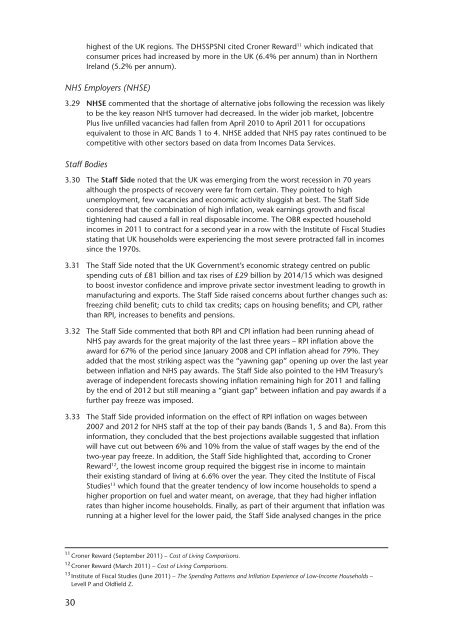NHS pay review body: twenty-sixth report 2012 - Official Documents
NHS pay review body: twenty-sixth report 2012 - Official Documents
NHS pay review body: twenty-sixth report 2012 - Official Documents
Create successful ePaper yourself
Turn your PDF publications into a flip-book with our unique Google optimized e-Paper software.
30<br />
highest of the UK regions. The DHSSPSNI cited Croner Reward 11 which indicated that<br />
consumer prices had increased by more in the UK (6.4% per annum) than in Northern<br />
Ireland (5.2% per annum).<br />
<strong>NHS</strong> Employers (<strong>NHS</strong>E)<br />
3.29 <strong>NHS</strong>E commented that the shortage of alternative jobs following the recession was likely<br />
to be the key reason <strong>NHS</strong> turnover had decreased. In the wider job market, Jobcentre<br />
Plus live unfilled vacancies had fallen from April 2010 to April 2011 for occupations<br />
equivalent to those in AfC Bands 1 to 4. <strong>NHS</strong>E added that <strong>NHS</strong> <strong>pay</strong> rates continued to be<br />
competitive with other sectors based on data from Incomes Data Services.<br />
Staff Bodies<br />
3.30 The Staff Side noted that the UK was emerging from the worst recession in 70 years<br />
although the prospects of recovery were far from certain. They pointed to high<br />
unemployment, few vacancies and economic activity sluggish at best. The Staff Side<br />
considered that the combination of high inflation, weak earnings growth and fiscal<br />
tightening had caused a fall in real disposable income. The OBR expected household<br />
incomes in 2011 to contract for a second year in a row with the Institute of Fiscal Studies<br />
stating that UK households were experiencing the most severe protracted fall in incomes<br />
since the 1970s.<br />
3.31 The Staff Side noted that the UK Government’s economic strategy centred on public<br />
spending cuts of £81 billion and tax rises of £29 billion by 2014/15 which was designed<br />
to boost investor confidence and improve private sector investment leading to growth in<br />
manufacturing and exports. The Staff Side raised concerns about further changes such as:<br />
freezing child benefit; cuts to child tax credits; caps on housing benefits; and CPI, rather<br />
than RPI, increases to benefits and pensions.<br />
3.32 The Staff Side commented that both RPI and CPI inflation had been running ahead of<br />
<strong>NHS</strong> <strong>pay</strong> awards for the great majority of the last three years – RPI inflation above the<br />
award for 67% of the period since January 2008 and CPI inflation ahead for 79%. They<br />
added that the most striking aspect was the “yawning gap” opening up over the last year<br />
between inflation and <strong>NHS</strong> <strong>pay</strong> awards. The Staff Side also pointed to the HM Treasury’s<br />
average of independent forecasts showing inflation remaining high for 2011 and falling<br />
by the end of <strong>2012</strong> but still meaning a “giant gap” between inflation and <strong>pay</strong> awards if a<br />
further <strong>pay</strong> freeze was imposed.<br />
3.33 The Staff Side provided information on the effect of RPI inflation on wages between<br />
2007 and <strong>2012</strong> for <strong>NHS</strong> staff at the top of their <strong>pay</strong> bands (Bands 1, 5 and 8a). From this<br />
information, they concluded that the best projections available suggested that inflation<br />
will have cut out between 6% and 10% from the value of staff wages by the end of the<br />
two-year <strong>pay</strong> freeze. In addition, the Staff Side highlighted that, according to Croner<br />
Reward12 , the lowest income group required the biggest rise in income to maintain<br />
their existing standard of living at 6.6% over the year. They cited the Institute of Fiscal<br />
Studies13 which found that the greater tendency of low income households to spend a<br />
higher proportion on fuel and water meant, on average, that they had higher inflation<br />
rates than higher income households. Finally, as part of their argument that inflation was<br />
running at a higher level for the lower paid, the Staff Side analysed changes in the price<br />
11 Croner Reward (September 2011) – Cost of Living Comparisons.<br />
12 Croner Reward (March 2011) – Cost of Living Comparisons.<br />
13<br />
Institute of Fiscal Studies (June 2011) – The Spending Patterns and Inflation Experience of Low-Income Households –<br />
Levell P and Oldfield Z.
















